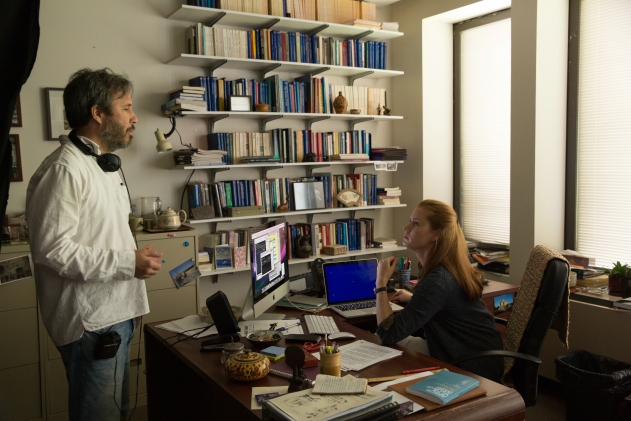
[Editor’s Note: Science & Film reached out to McGill University Professor of Linguistics Dr. Jessica Coon because she consulted on Denis Villeneuve’s film ARRIVAL. Dr. Coon advised on the character played by Amy Adams–a linguist named Dr. Louise Banks. In the film, Dr. Banks tries to communicate with an alien spacecraft which has landed in the United States. ARRIVAL premiered at the Venice Film Festival and is in wide release.]
Just after finishing my sophomore year in college, I arrived in Chiapas, Mexico for my first summer of linguistic fieldwork. My linguistics professor, renowned Mayanist John Haviland, drove us six hours down winding mountain roads from the city of San Cristóbal de las Casas into the hot Chiapan lowlands, to a Ch’ol-speaking Mayan village called Campanario. After negotiating my stay with a surprised host family to-be, Haviland got ready to head back to the city. Overwhelmed, with only rudimentary Spanish and my courage quickly slipping away, I asked him to remind me again what exactly I was supposed to do. “Make some friends,” he said casually, “learn some Ch’ol.”
I have to imagine that Dr. Louise Banks (played by Amy Adams), the fictional linguist and protagonist of the movie ARRIVAL, knows the feeling. A similar mixture of panic, excitement, and self-doubt must have begun to settle in as she was being rushed by military helicopter from her comfortable university office to the site of an enormous alien spaceship. There, she is tasked with deciphering the language of the recently-arrived Heptapods. In many ways, though, the comparison is hardly fair; I had Universal Grammar on my side.

Language sets humans apart from all other species. Human babies––remarkably unskilled at basic tasks like tying their shoes and adding sums of numbers––effortlessly learn any language to which they are sufficiently exposed. While children make mistakes along the path of acquisition, even these mistakes follow certain patterns and developmental trends. By the age of five, nearly every child has mastered a complex system that organizes sounds into sentences, and can produce and comprehend an infinite number of novel utterances––a feat that anyone who has tried to learn a new language as an adult can appreciate.
What linguists call “Universal Grammar” is the human capacity for language: core principles that all human languages share. At first glance, languages show a high degree of variation––the grammar of English is different from the grammar of Japanese, which is different from the grammar of Inuktitut––but linguists have discovered that languages vary in limited and constrained ways. In fact, languages tend to follow certain recipes in their grammars. The syntax of Japanese looks remarkably like the syntax of Quechua, an unrelated language indigenous to the Andes mountains in South America. Niuean, a Polynesian language spoken on the island of Niue, shares a number of grammatical properties with Ch’ol, the Mayan language I had arrived to study. Findings like these lead linguists to hypothesize that variation is constrained to certain parameters. Children acquiring language have a head-start: they come hard-wired with the basic building blocks of language.
Linguists working on understudied human languages benefit in different ways from the same head-start. A linguist who learns that a subject of a transitive sentence in Ch’ol triggers a special prefix on the verb is not surprised to also learn that possessors trigger an identical prefix on a possessed noun––because exactly this pattern is found in unrelated languages around the world. But when it comes to describing the grammar of ARRIVAL’s Heptapods, even the most basic human language distinction, like the difference between “nouns” and “verbs”, is no longer a given. Linguists who coined the term “Universal Grammar” had only the universe of human beings––not Heptapods––in mind.

In ARRIVAL, Dr. Banks approaches the daunting task of deciphering the Heptapod language as any good fieldworker would. Inside the Heptapod shell, she takes off her space suit and approaches the glass divide. While theoretical linguists are interested in the abstract properties of language––the formal system that allows us to put sounds together to make words, and words together to make sentences––access to that system is not direct, but must be done by careful work with native speakers of the language in question. As Dr. Banks knows, establishing a positive working relationship is the first step in any data-gathering activity. Dr. Banks also knows that progress doesn’t happen overnight. Despite the urgent orders of military generals to get to the point––why are they here?––Dr. Banks insists that she must start with the basics. Even seemingly benign concepts, like asking a question, may have no direct correlate in Heptapod.
It is this uncertainty about how an alien language might differ from human language that makes the premise of ARRIVAL so thought-provoking. The film, based on a short story by Ted Chiang, draws on the Sapir-Whorf Hypothesis: the idea that the language we speak constrains our view of the world. Among human languages––which follow the same underlying principles, and differ in interesting but ultimately constrained ways––this proposal has been shown to be not only wrong, but dangerous. (John H. McWhorter’s book The Language Hoax: Why the World Looks the Same in Any Language offers an accessible and fascinating look into why.) In fact, based on the deep commonalities among human languages, Noam Chomsky (the linguist shown in the photograph above Dr. Banks’ desk) has famously stated that a visiting Martian (or in the case of ARRIVAL, Heptapod) would view all human speech as essentially dialects of the same language. But when it comes to the language of the Heptapods, even the most skilled linguist has to admit that all bets are off. Will aliens have nouns and verbs, as we do, or understand the difference between a statement and a question, as we do?

Over the years since my first summer in Chiapas, I have continued working on Ch’ol. While learning Ch’ol did not alter my perception of reality, aspects of Ch’ol grammar have helped to shape linguistic theory. The scientific study of human language is relatively new, and many of the working theories about the principles and parameters of human language were developed on the basis of better-studied languages like English and French. Though huge leaps in understanding have been made in recent decades, it is crucial that linguists develop and test theories on a typologically and genealogically diverse set of languages. The theory of human language must account for the fact that children can acquire any language with ease––Niuean and Ch’ol as well as Russian and Spanish. In order to fully understand Universal Grammar, detailed work on the world’s understudied languages is critical.
This study is urgent. It is predicted that of the more than 6,000 languages spoken in the world today, up to 90% will no longer be spoken by the end of this century––unless big steps are taken to reduce current trends of language loss. In addition to contributing to our understanding of the range and limits of possible language variation, a growing body of research has shown that the health of a community’s indigenous language is a good predictor of other health and wellness factors. For indigenous communities, language reclamation may lead to a strengthened cultural identity and the empowerment of a historically marginalized population.
Though in the end it is communities, not outsider linguists, who revitalize a language, linguists can help. That first summer in Chiapas I did make friends––lifelong ones, along with a handful of god-children, one of whom is already a vocal advocate for education in Ch’ol, and is planning to be a linguist herself someday. As the film ARRIVAL shows, language is a powerful tool.
TOPICS